| Columns Retired Columns & Blogs |
Excellent review! LG.
Beautiful pics as well.
Setup
Todd Eichenbaum drove down from ECOE to help me schlep the two 114-lb shipping cartons containing the No.536es up the short flight of stairs into my listening room. We then donned white knit Mark Levinson gloves, complete with special gripping surfaces for lifting amplifiers. (Two pairs of these gloves are included with each mono amp.) We each grabbed one end of a heavy vinyl strap that ran under the No.536 and up through its heatsinks, to form loops at the amp's front and back. This allowed the two of us to easily lift the amplifiers out of their cartons and place them behind my Revel Ultima Salon2 speakers. Eichenbaum ran through each No.536's simple setup routine: rear-panel Power switch on; rear-panel input toggle set for balanced connection to my Bryston BP-26 or Mark Levinson No.526 preamplifiers; Green standby mode and front-panel Standby button pressed.
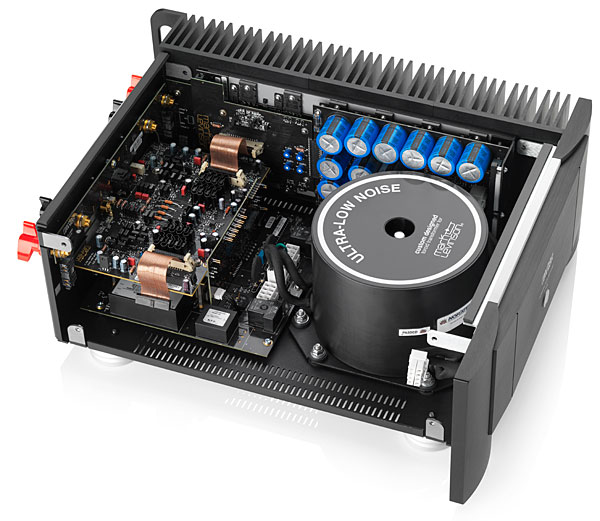
For most of the listening period, the No.536es were plugged into my Torus Power RM20 power conditioner. I also briefly plugged them directly into the wall outlets, and then into a voltage-regulated Torus Power AVR TOT, but could hear no differences.
After playing the No.536es at top volume for 15 minutes, I checked their output-stage temperatures via their internal webpages. To do that, I connected each amp to my network router using an Ethernet CAT5 cable, and to my laptop with a micro-USB link. The router assigned the amplifier an ISP address, and my laptop's browser displayed the internal webpage. The No.536's webpage showed the temperatures of the output stages and main circuit board, and confirmed that the standby mode was "2": Green, the factory default.
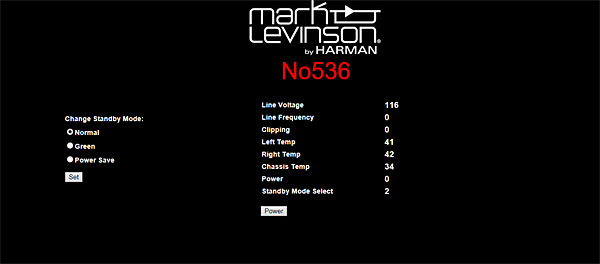
Listening
The No.536es' sound quality was immediately evident. They woke up my Revel Ultima Salon2 speakers, delivering an aural palette startling in its transparency and clarity, with an expanded ability to reproduce dynamic contrasts, compared with Mark Levinson's ML-2, No.27, and No.334 amplifiers. My first listening session produced the same epiphany I experienced on first hearing Theta Digital's Prometheus class-D monoblocks: Both sounded open, slightly bright, and whole from top to bottom. Needless to say, both pairs of amplifiers brought out the best from my Revels, which sounded incredibly dynamic and pleasingly fast, with greater punch and precision in their deep-bass response than I'd heard before.
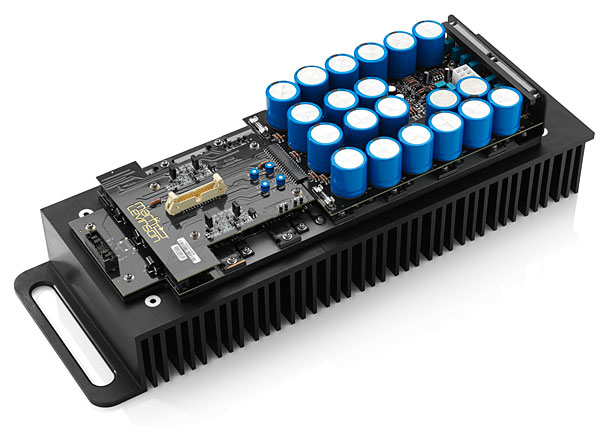
First impressions count. I soon adopted the No.536es as my go-to amplifiers for the next nine months' worth of reviewing. During the listening for my review of the Torus Power AVR TOT power conditioner, the Mark Levinsons played with surprising fullness and unexpectedly wide dynamic range, limited only by the Torus's 10-amp slow-blow fuse, which died when the No.536es drew a steady 16 amps. Driven by the No.536es, both my Quad ESL-63 and ESL-989 electrostatic speakers sounded more open and more dynamic, and developed unusually well-defined upper bass and sweeter, more open highs. The No.536es remained unperturbed when the Quads' protection circuits kicked in and short-circuited the terminals, producing none of the scratchy, staticky sounds or overheating warnings I've experienced with other amplifiers. When the Quads' protection circuits relaxed, the amps immediately turned back on.
The No.536 exerted a superior grip on the Salon2s' woofers, creating a powerfully deep, yet well-controlled and well-damped deep bass response. In the Toccata of Widor's Organ Symphony 5, as performed by Jonas Nordwall and recorded by John Atkinson (24-bit/88.2kHz AIFF file), deep pedal notes were reproduced with unflinching control and solidity, and pressurized my room. Similarly, the pedal note that ends James Busby's performance of Herbert Howells's Master Tallis's Testament, from Pipes Rhode Island (CD, Riago 101), was muscular and throbbing yet well controlled. The conga drum that opens "Hotel California," from the Eagles' Hell Freezes Over (CD, Geffen GEFD-24725), had a leaden, rock-like solidity, with no sustain. The No.536es were able to define and contain the massive bass chord that cuts in just after the beginning of "Deeper Well," from Emmylou Harris's Spyboy (CD, Eminent EM-25001-2), allowing her voice and the drums to be heard farther back on the soundstage.
One of the most striking things about the No.536 was its huge dynamic range and bass impact, as demonstrated by: the kickdrum that catapults the sleepy opening of David Bowie's "Putting Out Fire," from the Cat People soundtrack, into a driving rock anthem (CD, MCA MCAD-1498); the dense, solid bass-drum notes that erupt from silence in Eiji Oue and the Minnesota Orchestra's recording of Stravinsky's The Rite of Spring (24/176.4k PCM file, Reference RR-70); and the struck chimes and thunderous bass drum that tighten the suspense in "Assault on Ryan's House," from James Horner's score for Patriot Games (CD, RCA 66051-2).
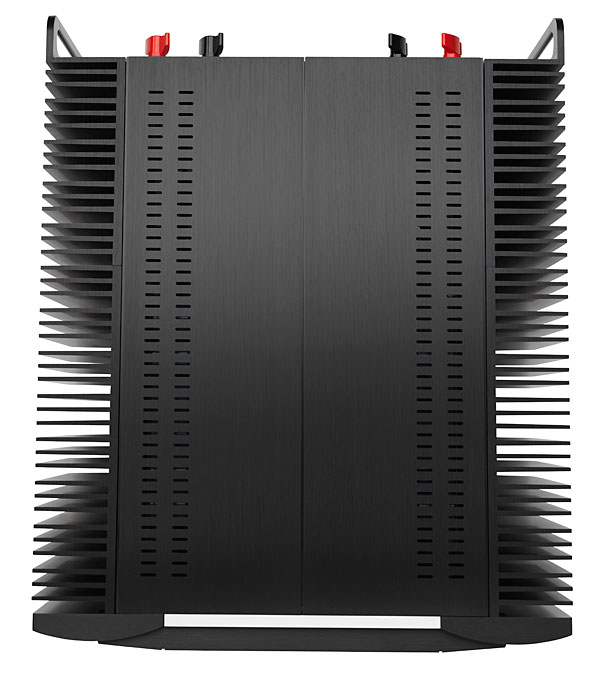
The midrange response blossomed when my speakers were driven by the No.536es. Whether the volume was low or high, it was easy to hear differences in tone and timbre in male voices, piano, and percussion. The No.536 made the timbres and harmonics of different solo male voices easy to distinguish, without added midbass emphasis. José Carreras's effortless, lyrical tenor floated before the arc of choristers in the Kyrie of Ariel Ramirez's Misa Criolla, in the recording conducted by José Luis Ocejo (CD, Philips 420 955-2). Large choral works benefited greatly from the No.536es' clarity, illumination and power. John Rutter's Lord, Make Me an Instrument of Thy Peace and the Piè Jesu from his Requiem, both with Timothy Seelig conducting the Turtle Creek Chorale (CD, Reference RR-57CD), revealed subtle tonal differences among the members of this male chorus, distinctions made possible by the No.536's precision. A Gaelic Blessing, on the same disc, revealed superb pitch definition of the pipe organ's pedal notes.
The No.536's midrange performance was highlighted by its ability to throw a wide, deep soundstage. "Breathe (in the Air)," from Pink Floyd's Dark Side of the Moon (SACD/CD, EMI 82136-2), engulfed me in sounds of throbbing helicopter rotors, jackhammers, footsteps, dive bombers, and PA announcements spread across a wide stage. In Rutter's Piè Jesu, the soprano, chorus, harp, and organ were each separate and precisely positioned, and the No.536es' excellent pitch definition allowed each descending pedal note to be heard.
The No.536es' reproduction of cymbals was exemplary. One of my favorite recordings of softly played cymbals is "Nardis," from Patricia Barber's Café Blue (SACD/CD, Premonition/Blue Note/Mobile Fidelity Sound Lab UDSACD 2002). In drummer Mark Walker's solo, as he played cymbals, drum heads and rims, and even different areas of a single cymbal, each was clearly depicted by the No.536.
Comparisons
My ca-1977 Mark Levinson ML-2 monoblocks (50W class-A into 4 ohms) conveyed the same smooth resonances of orchestral violins and violas, as well as the richness of woodwind timbres—but at significantly lower volumes than were possible with the No.536es. The ML-2s were leaner in the midrange and upper bass, but had unusually good pitch definition for deep bass, making it easy for me to follow Brady Blade's bass line in "The Maker," from Emmylou Harris's Spyboy. The Mark Levinson No.334, ca 1999, played with a warmer midrange, less percussive impact, darker overall tone, and narrower dynamic range. As I mentioned in my review of the No.526 preamp in May, the No.334 seemed compressed when compared to the No.536, which was faster, more transparent, more open, more emotionally involving.
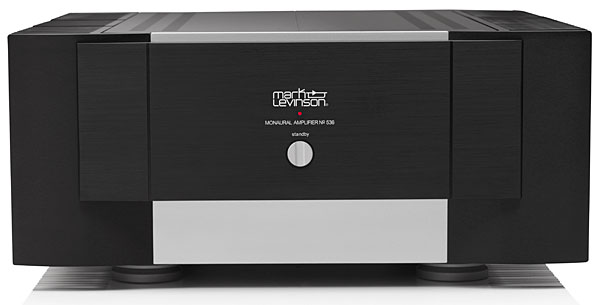
Conclusions
At $30,000/pair, the Mark Levinson No.536 is expensive. Only seven of the 25 top-rated solid-state power amplifiers listed in the April 2017 edition of Stereophile's "Recommended Components" cost more, and a similar number (not the same amps) can output more power into 8 ohms. But don't despair—Mark Levinson has just released a less expensive version of the No.536: the dual-mono, 250Wpc No.534 stereo amp ($20,000).
Does the No.536 have any drawbacks? Ruggedness, high output, and class-AB operation mean that an amp must be big and heavy, and require two people for unpacking. It could benefit from better instructions for accessing its internal webpage, and inclusion of a USB-micro cable. But, as those at Mark Levinson might say, these are easily recoverable faults.
Dinesh Paliwal has succeeded in revitalizing the Mark Levinson line, building a cutting-edge engineering team, and releasing a slew of high-end products. Among them is this super-rugged, expensive amplifier, which has exceptional sound quality. Nine months after I began listening to it, its soundstaging, imaging, speed, and wide-ranging dynamic contrasts remain spellbinding, equaled by only one or two other amplifiers in memory. The No.536 is definitely worth my strong recommendation that it be included in Class A of Stereophile's "Recommended Components."

Excellent review! LG.
Beautiful pics as well.

Thanks for the review Larry. I have found that these amplifiers are incredibly musical and revealing. Whether classical, vocal, or classic rock, they reveal all that is present in the recorded music. I noted a marked improvement of sound in my system when I introduced these in replacement of an ATI Sgnature 6007. Further refinement was achieved with the inclusion of the matching No. 523 preamplifier. Finally, they control my B&W 800 D2's with ease and finesse. I can't say enough about the pleasing sound of this combination.

you do know who makes the amps FOR mark levinson,,,,,right?

...who makes the amps?

...that wouldn't deter me. Given the small quantities to be sold, it wouldn't make much sense to setup their own production. ATI has a very good reputation, builds a lot of product, and has ultra high end experience with its ownership of Theta. It also allows ML to put "Made in USA" on the product. Somehow I doubt "Made in China" or "Made in Mexico" would go over very well. But it's a fact that the majority of Harman brands now build their products outside the US.

...who makes the amps?
To the best of our knowledge, the current generation of Mark Levinson-branded products is manufactured by Mack Technologies, in Westford, MA: http://www.macktech.com/.
John Atkinson
Editor, Stereophile

googoogjoob - some Levinson amps are made by ATI - that's been known for years. But not all ML amps are made by ATI, some amps, including the No. 536, are designed at "Mark Levinson's new facility in Shelton, Connecticut, where all listening tests and QC checks are also performed. Manufacturing is done at Mack Technologies, in Westford, Massachusetts." This is a quote of Mr. Greenhill's as made in Stereophile and on this web site as part of his review of the ML 585. I'm disappointed you missed that detail given it's importance and relativity to your failed inference.

Has anyone asked Mark, himself, what he thinks of the Mark Levinson Amplifiers?
Nelson Pass has plenty to say about the stuff with his name on it, as does B.H.King about that New PS Audio stuff.
Tony in Michigan
ps. I have plenty to say about everything with my name on it as does our JA, for gods sake

...Levinson give a tinker's damn about these amplifiers? He sold his namesake and his ownership of the company he founded many, many years ago and hasn't looked back since. Mark Levinson (the company) has undergone bankruptcy, numerous sales and acquisitions, finally landing in the Harman fold back in 1990. If he didn't like the amplifier, what then? He'd simply be told to go pound sand by the powers that be at Harman. Of course Nelson Pass has plenty to say about his amplifiers, because...well...he actually designed them, and he still owns a majority financial stake in the company known as Pass Labs.

In response to your comments, I went to Google and looked up a few videos of M.Levinson to discover his involvement in Audio today.
Geez, Mark Levinson is competing with his own Company Name, betcha that's a rarity.
Anyway, Hertz Co. seem to have the same Luxury Ideal that Harmon is doing with the Levinson Branding.
Levinson himself seems a capable salesman, his products seem aimed at the Affluent person wanting to be involved with music reproduction at a rather intimate level. ( Hertz stuff seems "tweaky" )
Hertz only offer the "Best" level, no good or better. Priced at $120,000 for the whole darn thing: Speakers, amps, pre-amp/DAC. So, it's a fully Active System capable of playing at 125db.
Nice looking stuff. I could own it but I'd be more likely to buy a Meridian System.
Well, so much for Mark Levinson.
Tony in Michigan
ps. I once considered the Levinson product line for my Retail Shop. None of us liked the stuff so we declined but did accept the Koetsu stuff. It was from Madrigal ( I think ) c.1985ish

As I understand the court rulings between Madrigal and Mr. Levinson, Mark Levinson (the person) is barred from commenting on Mark Levinson (the brand) by legal restraints.

....use ordinary household, 15amp, shared-power for a $30k amp? In your review you mentioned the Torus AVR TOT power conditioner blew its fuse when the 536 maintained a steady 16A draw. Your investment in gear is deserving of the power its demands.
For 12 years I plugged my 336 into its own 15A socket thinking it had what it needed. The rest of my gear had their own 15A lines as well - but all those lines were ultimately shared. It bugged me to the point where one day I got a few hospital grade 20A receptacles and installed 3 separate 20A lines in to my music room. The difference at first, was incredible. It felt like I released a bull into the street where everyone runs for cover. The midrange was so in my face, I had to turn down the volume down a bit and continue my assessment. The sound stage was wider and deeper and the presentation just effortless - less congestion - although I never knew it was congested before. Remember I'm dealing with an older amp by then and its crappy Phillips caps that were replaced 2x under warranty.
Eventually I began to hear more subtle detail, the white against the black if you will, deeper base that had more slam and control and it was tighter. The highs however, were not as warm as I had hoped and some music left me adrift. **My 32 had it's own line and my 360S/37 shared one line (3 total lines).** Surge protected at the box.
I had read here and there in forums that big wall power is what an amp needs, especially class A like your amazing ML2's. I can't believe I'd never done it before. My 336 is due to be recapped. I can't wait to hear it while its running through Cornell Dubilier's. I also wonder what a dedicated 30A line would sound like?
I would be interested to read what a follow up review would find if you plugged those amazing 536 mono blocks into 2 separate 20A lines. Thanks for a thorough review!
PS: **The installation of the 20A lines was a lot cheaper than a big dollar power conditioner. The $20 receptacles were also cryo treated.